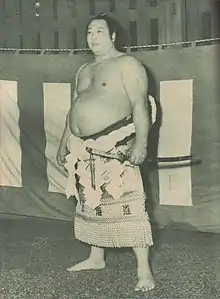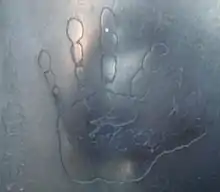Yoshibayama Junnosuke
Yoshibayama Junnosuke (Japanese: 吉葉山 潤之輔, April 3, 1920 – November 26, 1977), real name Ikeda Junnosuke (池田 潤之輔), was a Japanese professional sumo wrestler from Atsuta District, Hokkaido. He was the sport's 43rd yokozuna. He suffered a number of injuries and only won one tournament championship, but was a popular wrestler. He was a runner-up five times, and earned three special prizes and two gold stars in his top division career. After his retirement in 1958 he revived and led the Miyagino stable until his death in 1977.
| Yoshibayama Junnosuke | |
|---|---|
| 吉葉山 潤之輔 | |
 Yoshibayama, circa 1954 | |
| Personal information | |
| Born | Ikeda Junnosuke April 3, 1920 Hokkaidō, Japan |
| Died | November 26, 1977 (aged 57) |
| Height | 1.79 m (5 ft 10+1⁄2 in) |
| Weight | 143 kg (315 lb) |
| Career | |
| Stable | Takashima |
| Record | 357-171-85-1hold |
| Debut | May, 1938 |
| Highest rank | Yokozuna (January, 1954) |
| Retired | January, 1958 |
| Elder name | Miyagino |
| Championships | 1 (Makuuchi) 1 (Makushita) |
| Special Prizes | Outstanding Performance (3) |
| Gold Stars | 2 (Terukuni) |
| * Up to date as of June 2020. | |
Career
He entered sumo in a curious way. He had travelled to Tokyo on a train to attend school, but was met at the station by a sumo wrestler who was expecting a new recruit, who had in fact had second thoughts and not made the trip. The conspicuously large Ikeda was mistaken for him and taken back to Takashima stable before he even realised what was going on.[1] He made his professional debut in May 1938 using the shikona or ring name Hokutozan Junnosuke (北糖山 潤之輔). After suffering appendicitis he had to undergo emergency surgery and changed his ring surname to Yoshibayama in May 1939 in honour of the doctor (Shosaku Yoshiba) who had saved his life.[2] He got to the verge of promotion to the jūryō division in 1942 but was then drafted into the Japanese army and took part in World War II. He was seriously wounded in gunfights during his service. He was shot in the leg twice, and the second bullet permanently lodged itself in his foot.[2] He was actually reported as dead for some time. He came back alive, but was surprisingly thin when he returned to Japan. It is generally believed among sumo scholars that if he had not been conscripted and lost several years of his career, he could have become an even stronger and longer lasting wrestler than he was.[3]

In spite of his war injury, Yoshibayama returned to sumo in 1947 and was promoted to the top makuuchi division in November of that year. He remained in the maegashira ranks until September 1950. He was promoted to ōzeki in May 1951, after two successive runner-up performances of 13–2 at the rank of sekiwake. Yoshibayama recorded an azukari, or hold, on the 12th day of September 1951 tournament. The reason is that his opponent, Azumafuji, could not stand up any more. Yoshibayama could have been awarded a win, but sportingly insisted on a draw. In May 1953 he finished with 14 wins and only one loss, but the championship went to undefeated maegashira Tokitsuyama whom Yoshibayama had not been paired against.[2]
Yoshibayama was promoted to yokozuna after winning his first championship with a perfect 15–0 record in January 1954, but did not win a single bout at the rank until the autumn tournament of that year. He was unable to win any championships in his yokozuna career and had only one runner-up result. Although he was popular with the public, he ate and drank to excess and had several internal ailments, including kidney problems.[2] Having finally reached his physical limit, he announced his retirement during the January 1958 tournament. His old rival Kagamisato, who had been promoted to ōzeki alongside him in May 1951, also decided to retire on the final day, the first time that two yokozuna had quit in the same tournament.
Fighting style
Because of the bullet in his ankle, Yoshibayama's style of fighting was erratic. It also did not help that his favourite technique was the controversial ketaguri, or leg kick,[4] which was considered to be unacceptable at his top yokozuna rank. Scholars conceded however that Yoshibayama had had little time to master acceptable sumo techniques because of his time out of sumo due to the war.
Retirement from sumo

After his retirement, Yoshibayama became the 8th head coach of Miyagino stable. The previous head coach was the 24th yokozuna Ōtori, but Miyagino stable was closed once after his death in 1956. While still an active wrestler, he managed his own stable, a practice no longer permitted. Ōtori's son-in-law Fukunosato Ushinosuke belonged to his stable. He officially renamed his stable to Miyagino stable in 1960. He developed a number of top division wrestlers, such as Myōbudani. He was also a judge of tournament bouts, and on the Japan Sumo Association's board of directors. He also opened a number of chankonabe restaurants that still operate today.[2]
Future makuuchi wrestler Chikubayama also joined his stable, but could not reach the top makuuchi division by 1977 when Yoshibayama died. Chikubayama accepted future yokozuna Hakuhō when he was the Miyagino stablemaster. Yoshibayama performed the yokozuna dohyō-iri (ring entering ceremony) in the shiranui style. When Hakuhō was promoted to yokozuna, he succeeded Yoshibayama's style. At the Meiji Jingu shrine on June 1, 2007, Hakuhō performed the ring entering ceremony wearing Yoshibayama's keshō-mawashi and used a sword (tachi) of another yokozuna, Ōtori.[5]
Pre-modern career record
- Through most of the 1940s only two tournaments were held a year. In 1953 the New Year tournament was begun and the Spring tournament began to be held in Osaka. The Kyushu tournament was first held in 1957, and the Nagoya tournament in 1958.
| - | Spring Haru basho, Tokyo |
Summer Natsu basho, Tokyo |
Autumn Aki basho, Tokyo |
|||
|---|---|---|---|---|---|---|
| 1938 | x | (Maezumo) | Not held | |||
| 1939 | East Jonokuchi #11 2–5 |
West Jonidan #68 6–2 |
Not held | |||
| 1940 | West Jonidan #12 7–1 |
East Sandanme #29 7–1 |
Not held | |||
| 1941 | East Makushita #28 7–1 |
West Makushita #5 3–5 |
Not held | |||
| 1942 | East Makushita #10 5–3 |
East Makushita #1 7–1 Champion |
Not held | |||
| 1943 | Out of sumo | Out of sumo | Not held | |||
| 1944 | Out of sumo | Out of sumo | Out of sumo | |||
| 1945 | Not held | Out of sumo | Out of sumo | |||
| 1946 | Not held | Not held | Out of sumo | |||
| 1947 | Not held | East Jūryō #4 9–1–P |
East Maegashira #13 8–3 |
|||
| 1948 | Not held | East Maegashira #7 8–3 |
East Maegashira #2 5–6 ★ |
|||
| 1949 | East Maegashira #3 7–6 |
East Maegashira #3 2–13 |
East Maegashira #10 10–5 |
|||
| 1950 | East Maegashira #3 10–5 O★ |
East Maegashira #1 10–5 O |
East Sekiwake #2 13–2 O |
|||
| 1951 | East Sekiwake #1 13–2 |
West Ōzeki #1 10–5 |
East Ōzeki #1 9–5–1hold |
|||
| 1952 | West Ōzeki #1 12–3 |
East Ōzeki #1 10–5 |
West Ōzeki #1 12–3 |
|||
| Record given as win-loss-absent Top Division Champion Top Division Runner-up Retired Lower Divisions Sanshō key: F=Fighting spirit; O=Outstanding performance; T=Technique Also shown: ★=Kinboshi; P=Playoff(s) | ||||||
| - | New Year Hatsu basho, Tokyo |
Spring Haru basho, Osaka |
Summer Natsu basho, Tokyo |
Autumn Aki basho, Tokyo | ||
|---|---|---|---|---|---|---|
| 1953 | West Ōzeki #1 6–3–6 |
West Ōzeki #1 10–5 |
West Ōzeki #1 14–1 |
East Ōzeki #1 11–4 |
||
| 1954 | East Ōzeki #1 15–0 |
West Yokozuna #1 Sat out due to injury 0–0–15 |
West Yokozuna #2 0–1–14 |
West Yokozuna #2 11–4 |
||
| 1955 | West Yokozuna #2 5–2–8 |
East Yokozuna #3 3–2–10 |
West Yokozuna #2 0–2–13 |
West Yokozuna #2 9–6 |
||
| 1956 | East Yokozuna #2 9–6 |
West Yokozuna #1 11–4 |
East Yokozuna #1 8–7 |
East Yokozuna #2 12–3 |
||
| Record given as win-loss-absent Top Division Champion Top Division Runner-up Retired Lower Divisions Sanshō key: F=Fighting spirit; O=Outstanding performance; T=Technique Also shown: ★=Kinboshi; P=Playoff(s) | ||||||
Modern top division record
- Since the addition of the Kyushu tournament in 1957 and the Nagoya tournament in 1958, the yearly schedule has remained unchanged.
| Year in sumo | January Hatsu basho, Tokyo |
March Haru basho, Osaka |
May Natsu basho, Tokyo |
July Nagoya basho, Nagoya |
September Aki basho, Tokyo |
November Kyūshū basho, Fukuoka |
|---|---|---|---|---|---|---|
| 1957 | West Yokozuna #1 10–5 |
East Yokozuna #2 3–3–9 |
West Yokozuna #2 5–6–4 |
Not held | East Yokozuna #2 9–6 |
West Yokozuna #1 11–4 |
| 1958 | West Yokozuna #1 Retired 3–6–6 |
|||||
| Record given as win-loss-absent Top Division Champion Top Division Runner-up Retired Lower Divisions Sanshō key: F=Fighting spirit; O=Outstanding performance; T=Technique Also shown: ★=Kinboshi; P=Playoff(s) | ||||||
See also
References
- Sharnoff, Lora (1993). Grand Sumo. Weatherhill. p. 6. ISBN 0-8348-0283-X.
- Kuroda, Joe (August 2007). "Rikishi of Old" (PDF). Sumo Fan Magazine. Retrieved 2008-06-20.
- Newton, Clyde (1994). Dynamic Sumo. Kodansha. p. 63. ISBN 4-7700-1802-9.
- 止むに止まれぬ「けたぐり」(第43代横綱・吉葉山) (in Japanese). Nihon Sumo Kyokai. Retrieved 2008-06-14.
- 白鵬が奉納土俵入り 朝青龍超えた (in Japanese). Daily Sports. 2007-06-02. Archived from the original on July 5, 2007. Retrieved 2008-11-24.
- "Yoshibayma Junnosuke Rikishi Information". Sumo Reference. Retrieved 2007-10-01.